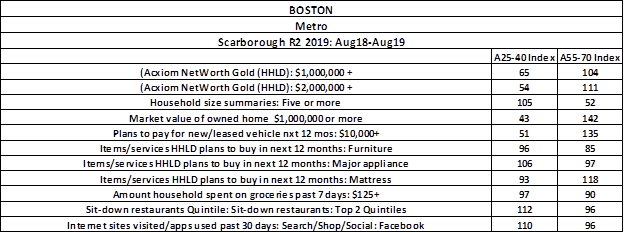
(By Bob McCurdy) The following is not quite as important as convincing an advertiser to retain a “voice” today but nonetheless it is important when it comes to delivering the maximum payback when they do re-discover their “voice” in the future.
There will be a lot of “resetting” going over the next few months and one thing that needs to be re-set is the 25-54 demo by at least a decade. The world has just been through dramatic change. Maybe it is time this demo changes just a little.
An article, Boomers are Just Millennials with Money, caught my eye. You can read it here. It would seem logical that a more “inclusive” marketing approach post Corona would lead to additional, much needed sales than a more “exclusive” approach. Local businesses will need revenue.
Some of the articles takeaways:
-When it comes to Boomers, marketers should throw away any age preconceptions and think of them as “millennials with money” who their own their homes.
-There are more similarities between boomers and other generations than differences. The author cited a U.S. study that found significant differences did not exist between baby boomer and millennial males.
-That same study described boomers’ expectations of brands as quality, service and competitive price – which doesn’t suggest any dramatic generational difference.
-Marketers should follow the example of Microsoft, which bans demographics and instead segments consumers by mindset (psychographics).
-Brands need to take a more progressive and positive attitude to age. Being older does not mean having an “old” mindset.
Who is more likely to emerge financially intact from the past several months, the Millennial with three kids and a mortgage or the Boomer with their homes paid off and no kids at home?
Is the Millennial and Boomer profile that much different? Their purchasing habits appear similar except for the resounding wealth advantage of the Boomer. The chart below looks at Boston using the latest Scarborough.

This past week WARC summarized a study that concluded that the 65+ demo will be the growth engine of American e-commerce growth. Over 65? Is it possible? Yep.
The limitations of demographics will continue to grow as gender roles continue to evolve and Boomers age. Marketers devote considerable resources trying to understand the preferences of various “generations” but they would achieve better results if they based their research on behavior and attitudes regardless of age as consumers today are too complex and nuanced to be fully understood by overly narrow, traditional demographics.
It is time to expand the 25-54 demo to 25-64 or 25-74 for maximum ROI to jumpstart the post virus economy.
BTW, there was a radio PPM study conducted in Canada that supports the 2011 Arbitron study regarding radio audience retention during commercial breaks. The article, which appeared in the March issue of the Journal of Advertising Research titled, A New Benchmark for Mechanical Avoidance of Radio Advertising: Why Radio Advertising is a Sound Investment.
Using Canadian PPM data, the authors discovered only 3 percent for physical avoidance of radio advertising, such as switching stations or turning off the radio during a commercial break. The 2011 Arbitron study concluded that on average, radio delivers 93% of its lead-in audience during commercial breaks, which is in line with this Canadian study’s 97%. Something to keep in mind when someone says no one listens to radio commercials.
Bob McCurdy is now retired and can be reached at [email protected]






IT’S ABOUT TIME!